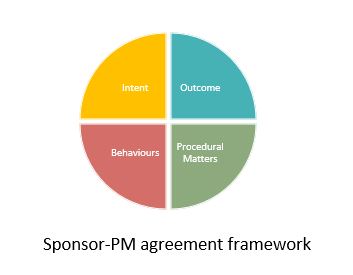I have conducted literally hundreds of project/contract reviews from setup to post-implementation reviews across many industries and often come back to the above critical question.
The first and most critical step in a project is the singularly most avoided deliverable. It is not what you might think.
Get your I-BOP agreed first!
What the hell is an I-BOP? Never heard of it? Can’t find it in PM-BOK, Prince 2, Agile or any other methodology? Therefore, cannot be important? Hopefully, after this article you will see things a little differently.
I-BOP is….
I-BOP stands for Intent, Behaviours, Outcome, Procedures and is represented visually below. It is intended to form the basis of an agreement between the sponsor and PM.

This agreement model is designed to create an integrative agreement, clarify the approach to the project and has been used successfully across many of my projects. The objective is to remove assumptions between those critical players in the project and set the relationship up for success.
Breaking down the model you see that the top hemisphere describes the what of the project beyond what is written in the business case. Get the reasoning behind the project from the horse’s mouth.
The bottom hemisphere is the how of the relationship. Here things such as feedback approach, access, how we work together successfully is defined and agreed.
As an aside you will notice that the left hemisphere is representative of the intangible and the right hemisphere is the tangible.
Why do I-BOP first?
Clearly, the first thing should be finalising the brief or get governance up and running or hiring the team etc. I postulate how can you do these things well if you have not agreed with the sponsor what this project is about?
All projects have difficult times. Those difficult times are best managed when you have a well formulated and pre-agreed agreement in place leading into the challenging times.
As the lead project professional, you are at your most powerful state at the beginning of the project and therefore should use that power to establish a well formulated agreement.
As the sponsor your goal is to mitigate risk and remove misunderstandings. Again, this agreement achieves that for this project.
Why don’t you do it?
When I ask sponsors, this question the dominant response is that the PM should lead this discussion if they need it. Whereas the project professional assumes they already have the agreement until it is obvious, they do not. By that stage they lament rather than seek to deal with the gap. They feel uncomfortable confronting the sponsor at such a late stage when things are not going according to plan. The key message here is that you cannot manage what you have not agreed. So go through the effort to agree how the relationship will work before it becomes an issue.
Back to the original question. Who’s responsible? My position is the project professional is the project expert so they should take the lead to ensure it is done and done well. However, an experienced sponsor will make sure it is done if the project professional does not initiate the conversation.
